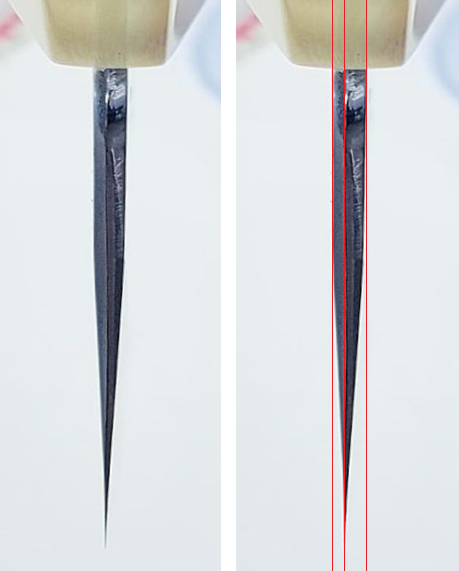masibu
Senior Member
- Joined
- Nov 5, 2012
- Messages
- 322
- Reaction score
- 7
Before I get into my post, just wanna be clear that I'm referring more to edge strength than I am to steering although I would assume there may be a difference in the way our knives cut
I figured you were referring to shallower angles but I think what I was trying to confirm was whether the microbevel is put on the right hand side in your case is because of the shallower angle or because of the shorter bevel on the right hand side. I'm assuming from the pictures that you're grinding more on the left hand side at an obtuse angle (compared to the right hand side) and also developing taller bevels. I would assume that sharpening this way would lead to the apex favouring the right hand side in your case and the micro bevel on the right hand side would then be beneficial to centre it/straighten it more and strengthen it?
I'm going back to that chisel analogy though now and the microbevel is put on the wider bevel, which is the opposite to what you're doing? However that is single edged and different to a knife. In my case the apex is going to slightly favour the left hand side (but at a shallower angle in comparison I would assume than with your knife as i sharpen the right side at a lower angle) and so it probably would make more sense to microbevel the left hand side.
I'm curious because if I'm using the shallower angle on the right hand side (but the bevels are wider), would it be more beneficial to micro bevel both sides (smaller angles than I would if applying it to just the one side) compared to applying it to just one side? Looking back at that chisel again (and realising that my edge probably starts to resemble a chiselesque edge although not as extreme) I'm questioning whether I should be microbevelling the shallow angled and wider right bevel and then end up going round in circles.
Again thanks for the response. At this point I guess im obsessing over the details and I would probably benefit from trying your method on another knife just to compare differences
No problem!
I can see why this is confusing.
The terms 'shallow' (acute) and 'obtuse' are directly related to sharpening angles. The descriptors 'shallow' and 'higher' are used for angle because of how we hold the spine at a certain height from the stone while sharpening.
The terms 'short' and 'wide' (long) refer to the length of surface area the bevel covers as it moves up the blade face. Some people use time on the stones as an indicator for short or long bevels (e.g. "sharpen twice as many strokes on the left side") but this is actually a terrible way of describing surface area as it holds little regard for both the condition of the blade prior to sharpening and the angles being used (e.g. grinding a shallow angle over an obtuse one can take a lot of time, but doing the reverse takes seconds).
I figured you were referring to shallower angles but I think what I was trying to confirm was whether the microbevel is put on the right hand side in your case is because of the shallower angle or because of the shorter bevel on the right hand side. I'm assuming from the pictures that you're grinding more on the left hand side at an obtuse angle (compared to the right hand side) and also developing taller bevels. I would assume that sharpening this way would lead to the apex favouring the right hand side in your case and the micro bevel on the right hand side would then be beneficial to centre it/straighten it more and strengthen it?
I'm going back to that chisel analogy though now and the microbevel is put on the wider bevel, which is the opposite to what you're doing? However that is single edged and different to a knife. In my case the apex is going to slightly favour the left hand side (but at a shallower angle in comparison I would assume than with your knife as i sharpen the right side at a lower angle) and so it probably would make more sense to microbevel the left hand side.
I'm curious because if I'm using the shallower angle on the right hand side (but the bevels are wider), would it be more beneficial to micro bevel both sides (smaller angles than I would if applying it to just the one side) compared to applying it to just one side? Looking back at that chisel again (and realising that my edge probably starts to resemble a chiselesque edge although not as extreme) I'm questioning whether I should be microbevelling the shallow angled and wider right bevel and then end up going round in circles.
Again thanks for the response. At this point I guess im obsessing over the details and I would probably benefit from trying your method on another knife just to compare differences
Last edited:






